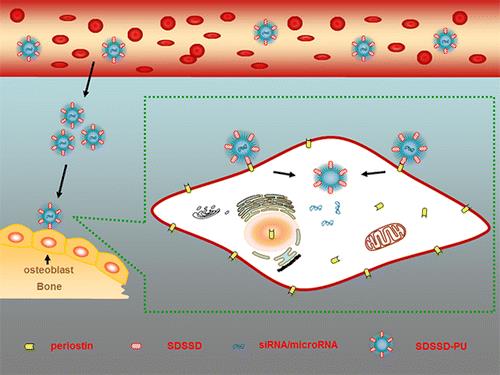王晓刚课题组成功研制高效低毒靶向成骨细胞的小核酸递送系统
2016-06
文章来自: 阅读次数:479
随着我国老龄化进程的加速,骨质疏松症成为老年人的常见病和高发病。目前的骨质疏松药物多是通过抑制骨吸收来降低骨丢失速率,而无法恢复以及丢失的骨量。近年来,医学界开始尝试通过siRNA/miRNA等小核酸来促进骨形成,进而对抗骨质疏松。但是因为缺乏成骨细胞特异性的小核酸递送系统而严重制约了药物的研发进程。
为解决如上问题,生科院王晓刚副研究员带领的课题组与同济大学孙瑶团队经过三年多的联合攻关,在世界上首次成功研制了一种新的高效低毒靶向成骨细胞的小核酸递送系统,使骨形成速率加快,推进了骨质疏松药物的研发进程。该研究论文于2016年5月18日在线发表于国际知名学术期刊《Acs Nano,IF2014=12.8》。
课题组通过筛选得到了特异性靶向成骨细胞的SD多肽,然后将SD多肽与PU纳米胶束偶联,得到了大小为约70 nm,可以负载小核酸的新型药物递送系统。在小鼠实验中该系统可以“精确制导”,特异性的将小核酸递送到成骨细胞中,并且没有明显的毒副作用,也不会产生明显的免疫反应。实验数据表明,骨质疏松小鼠经过使用该递送系统包裹的miR-214抑制剂治疗后,骨量显著恢复,骨形成速率明显加快。
我校2012级本科生叶雄珍同学是论文的共同第一作者,生科院王晓刚副研究员为论文的通讯作者。暨南大学为论文的第一完成单位。本研究得到了国家自然科学基金与广东省自然科学基金的资助。
原文链接:http://dx.doi.org/10.1021/acsnano.5b07828
Osteoblast-Targeting-Peptide Modified Nanoparticle for siRNA/microRNA Delivery
Antiosteoporosis gene-based drug development strategies are presently focused on targeting osteoblasts to either suppress bone loss or increase bone mass. Although siRNA/microRNA-based gene therapy has enormous potential, it is severely limited by the lack of specific cell-targeting delivery systems. We report an osteoblast-targeting peptide (SDSSD) that selectively binds to osteoblasts via periostin. We developed SDSSD-modified polyurethane (PU) nanomicelles encapsulating siRNA/microRNA that delivers drugs to osteoblasts; the data showed that SDSSD–PU could selectively target not only bone-formation surfaces but also osteoblasts without overt toxicity or eliciting an immune response in vivo. We used the SDSSD–PU delivery system to deliver anti-miR-214 to osteoblasts and our results showed increased bone formation, improved bone microarchitecture, and increased bone mass in an ovariectomized osteoporosis mouse model. SDSSD–PU may be a useful osteoblast-targeting small nucleic acid delivery system that could be used as an anabolic strategy to treat osteoblast-induced bone diseases.


